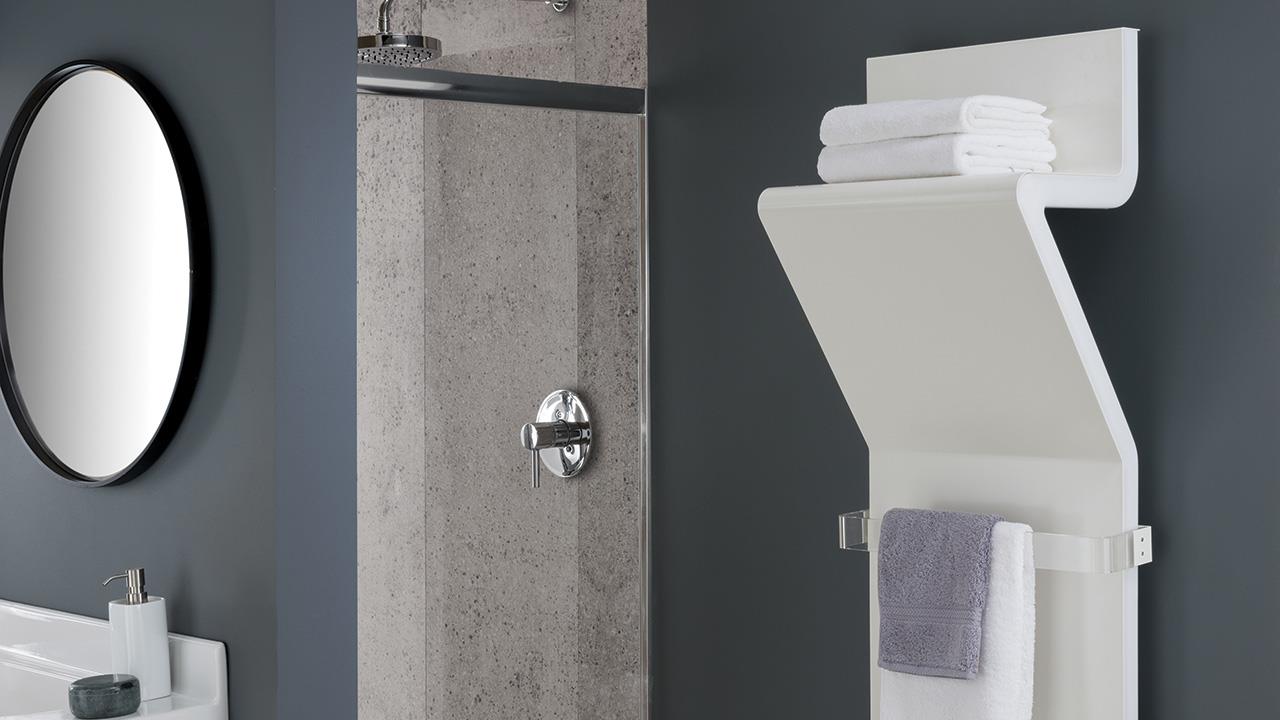

Simon Morris, Marketing Manager from The Radiator Company, explains the factors to consider when choosing a designer towel rail to match your customer’s vision.
Across the country, Britons have been using their time during lockdown to reassess their living space. A recent survey by Checkatrade found the UK is preparing to spend £61.8bn on home improvements when lockdown restrictions lift, with bathrooms revealed as one of the rooms homeowners disliked the most.
Whether customers plan to undertake an entire remodel or a simple update, it’s important not to overlook how the space will be heated and there are several factors to consider before making a choice.
How much heat?
A bathroom needs to be heated correctly to provide a comfortable environment. Opting for a towel rail can provide warmth and comfort, as well as the practical option to hang and warm towels. Professional installers will be aware that, before undertaking any radiator or towel rail installation, it is critical to calculate the heat output required (BTU). This helps to ensure that the appliance will sufficiently heat the room and won’t underperform leaving the customer with a chilly bathroom.
Here, opting for quality is important. Manufacturers should be able to supply towel rails that sufficiently heat the room with BTU performance that can stand up to its claims. Key indicators to look for are CE approval, EN 442 certification, and BTU calculations based on Delta T50. Another sign of assurance is whether the manufacturer is registered as a member of the Manufacturers’ Association of Radiators and Convectors (MARC), which uses approved RADMAC-certified laboratories to certify products in accordance with legislation.
Plumbed or electric?
There are several options when installing a towel rail for customers with a plumbed central heating system, with a choice of either a plumbed or electric version. Plumbed towel rails can use existing pipework with a similar sized unit for minimal disruption and quicker installation. But, rather than be limited by this option, new pipework can be installed after the heated towel rail has been chosen.
Electric options are a good solution to avoid extending the existing hot water heating system or moving pipework. Electric towel rails can be connected to the existing mains electric system and offer the flexibility for households to turn the towel rail on and off instantly, as and when it is needed.
Dual fuel offers the best of both worlds, with the greatest flexibility for households to either use the plumbed central heating supply, or independent heating using an electric supply when the central heating system is turned off. This is particularly useful during the summer months when the central heating is turned off but a warm bathroom towel is still appreciated.
Different styles
Every bathroom is different and leading manufacturers will be able to offer a wide choice of designs and finishes to suit any desired aesthetic and style.
Ladder towel rails are probably the most recognisable style of towel rail, but these need not be humdrum. Curved options are a fantastic choice for larger households hanging lots of towels and horizontal-orientated ladder rails are an ideal solution for above a bath, or where space is more restricted.
Towel rails with traditional features can be a beautiful feature in a bathroom and are particularly well suited for period homes. Ball-joint connections, column radiator sections, and antique galvanised finishes all can add character combined with the benefits of modern technology. For example, the ‘Chalfont’ floor standing column radiator has hanging bars for towels that can be finished in bronze, copper, or nickel for a more rustic and interesting aesthetic. This traditional design can even be manufactured with a modern electric supply.
Customers may not have considered a towel rail as a statement feature, so create some wow factor with your clients and offer styles that offer something more unique. The Radiator Company has designer options such as the ‘Relax Bagno’ – a towel rail that has a mirror-like, reflective finish, and ‘Tratto’ an artistic, three dimensional design with curved shelving and optional halo LED side strips to add drama to the space.
Think beyond simple white
Once you have chosen the style, check whether the manufacturer offers different colour options and finishes. Delight your customer by going beyond the usual white or chrome and suggest a towel rail that either blends with or matches their décor paint, or makes a powerful colour statement.
Customers will often have very clear ideas on their vision for a bathroom renovation – whether it be to create a sanctuary and somewhere to soothe and wind down, or a functional room, simply to wash and get ready at the beginning and end of each day. Matching their vision with the space and budget available can be tricky, so it’s important to use a manufacturer that has a broad range of styles and finishes, both stocked and to order, that will match their expectations.
If you'd like to keep up-to-date with the latest developments in the heating and plumbing industry, why not subscribe to our weekly newsletters? Just click the button below and you can ensure all the latest industry news and new product information lands in your inbox every week.